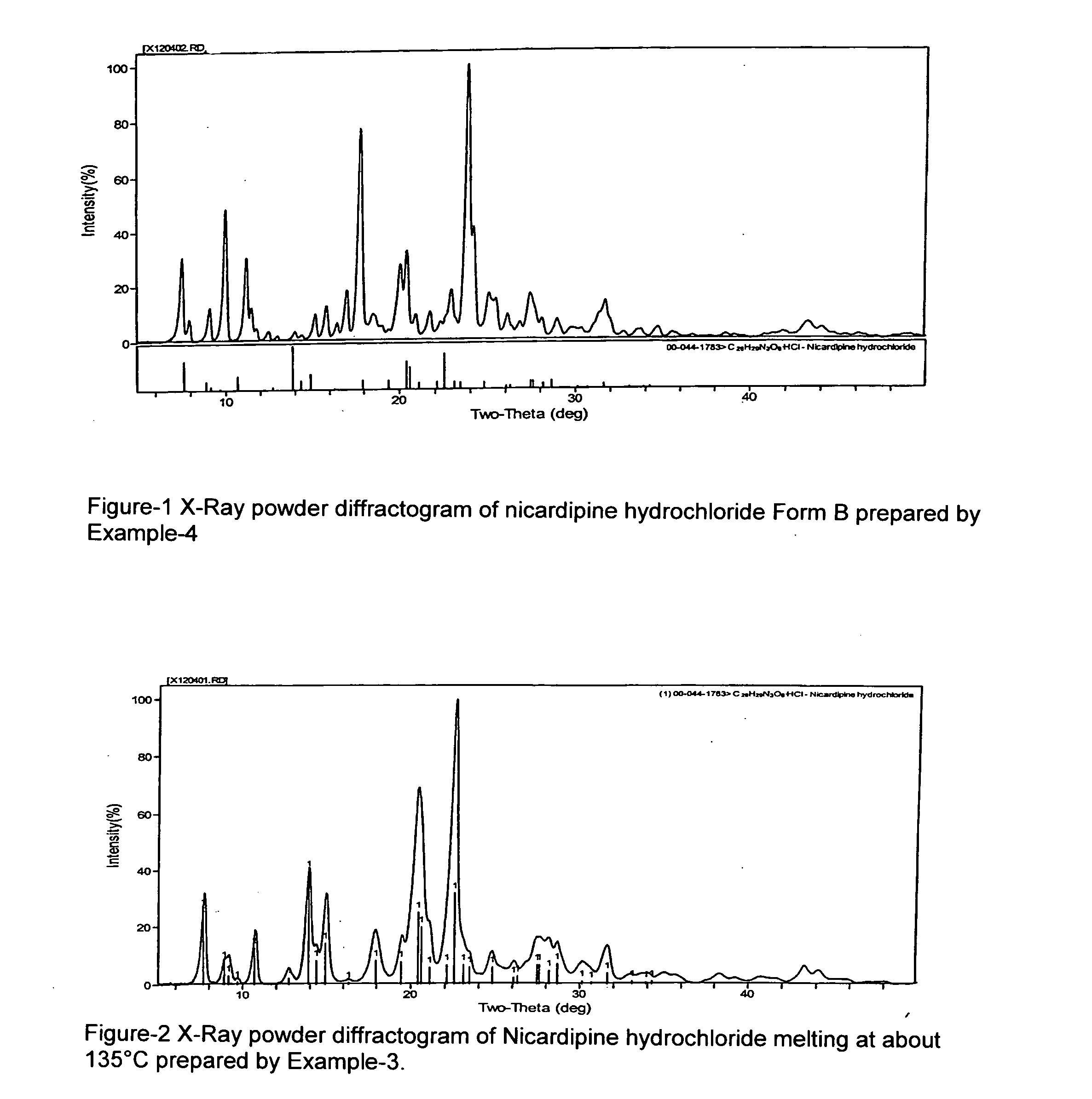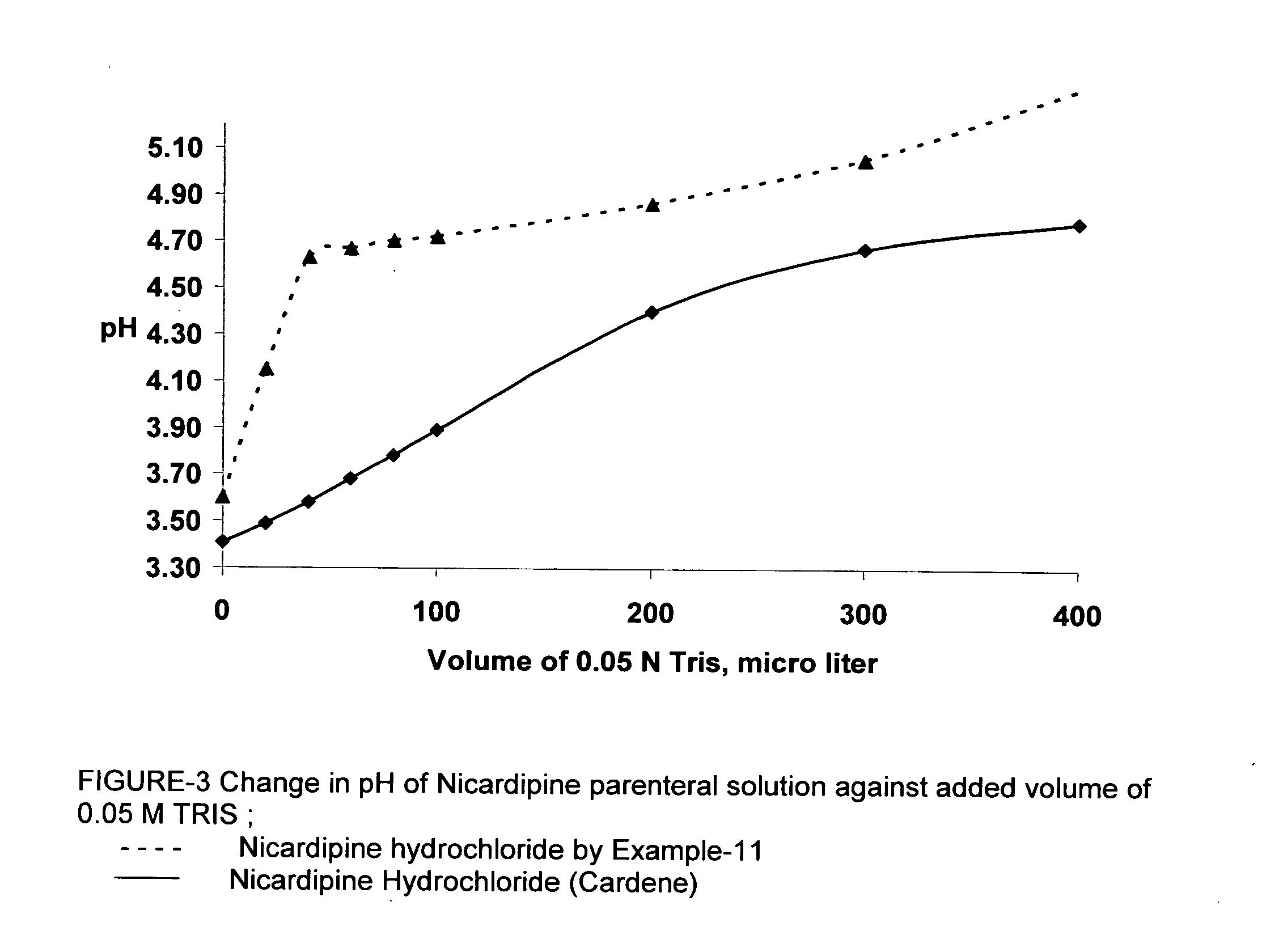Processes of manufacturing substituted-1,4-dihydropyridines, improved aqueous solutions thereof, and processes of manufacturing the solutions
a technology of dihydropyridine and manufacturing process, which is applied in the field of manufacturing substituted1, 4dihydropyridine, and improving aqueous solutions thereof, can solve the problems of poor overall yield of nicardipine using this procedure, lack of purity in intermediates, and difficult to achieve the effect of improving yield and purity, good yield and purity
- Summary
- Abstract
- Description
- Claims
- Application Information
AI Technical Summary
Benefits of technology
Problems solved by technology
Method used
Image
Examples
example 1
Preparation of Nicardipine Hydrochloride with 2 Equivalent of Aldehyde
[0046]Into a round bottom flask fitted with a thermometer pocket, reflux condenser and a mechanical stirrer, added acetoacetic acid 2-(N-benzyl-N-methylamino)ethyl ester (100.0 g, 400 mmol), methyl 3-aminocrotonate (46.2 g, 400 mmol) and 3-nitro benzaldehyde (121.25 g, 800 mmol) and 2500 mL isopropyl alcohol. Slowly raised the temperature of the reaction mixture to about 80° C. until the completion of the reaction (monitored by HPLC). The residue obtained after evaporation of isopropanol was dissolved in 800 mL ethyl acetate. The unreacted excess aldehyde was removed by extraction of the ethyl acetate solution with aqueous sodium bisulfite solution. Further the ethyl acetate layer was treated with dilute hydrochloric acid. The aqueous layer was discarded. The ethyl acetate layer was dried with sodium sulfate and cooled to about 0 to 5° C. and stirred for about 2 hrs. The precipitate was isolated by filtration. The...
example 2
Preparation of Nicardipine Hydrochloride Form A
[0047]The crude nicardipine hydrochloride (140 g) prepared as in Example 1 was dissolved in 500 ml methanol and then concentrated by evaporation under vacuum into a thick mass. Acetone (500 ml) was added and the solution filtered to remove any insoluble matter. Another 500 mL acetone was added and stirred for about 8 hrs to precipitate the hydrochloride salt at about 0 to −10° C. The filtered solid was washed with chilled acetone followed by drying under vacuum at about 50° C. Melting point 170° C. (indicative of Form A): yield 130 g. The powder XRD data of this sample matched that of nicardipine hydrochloride published in International center of diffraction data (00-044-1783).
example-3
Preparation of Nicardipine Hydrochloride Form a
[0048]The crude nicardipine hydrochloride (140 g) prepared as in Example 1 was dissolved in 500 ml methanol and then concentrated by evaporation under vacuum into a thick mass. Acetone (1000 ml) was added, and then added about 2 g of nicardipine hydrochloride Form A, and stirring slowly for about 8 hrs precipitated the hydrochloride salt at about 0 to −10° C. The filtered solid was washed with chilled acetone followed by drying under vacuum at about 50° C. Melting point 170° C. (Form A). Yield 130 g. Powder XRD data of this sample (FIG. 2) matches to that of nicardipine hydrochloride published in International center of diffraction data (00-044-1783).
PUM
| Property | Measurement | Unit |
|---|---|---|
| temperature | aaaaa | aaaaa |
| pKa | aaaaa | aaaaa |
| pKa | aaaaa | aaaaa |
Abstract
Description
Claims
Application Information
 Login to View More
Login to View More - R&D
- Intellectual Property
- Life Sciences
- Materials
- Tech Scout
- Unparalleled Data Quality
- Higher Quality Content
- 60% Fewer Hallucinations
Browse by: Latest US Patents, China's latest patents, Technical Efficacy Thesaurus, Application Domain, Technology Topic, Popular Technical Reports.
© 2025 PatSnap. All rights reserved.Legal|Privacy policy|Modern Slavery Act Transparency Statement|Sitemap|About US| Contact US: help@patsnap.com



